How To Repair Water Mark On Drywall
How to Repair Drywall Water Damage
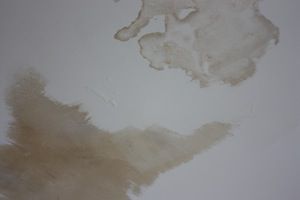
When water leaks onto drywall it tin can cause minor damage like stains on the paint finish; very severe damage like bulging in the wallboard; or some caste of impairment in between such equally bubbling joint chemical compound and peeling tape and paint.
How to Repair Pocket-sized Water Damage
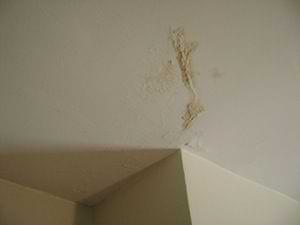
Use setting-type joint chemical compound, also chosen mud, for water damage repairs to drywall. Set-mixed compound volition not be hard plenty and information technology'south vulnerable to any residual moisture in the wall cloth.
Remove bubbles joint chemical compound and paint using a putty knife to scrape off all the damaged material. Remove peeling joint record past cut it costless. Trace the record back to simply outside the damaged area and cutting straight across it with a utility knife. Pull the loose tape off and scrape away any loose joint compound.
Brush or vacuum abroad the scraping grit and prime number all the affected wallboard with primer-sealer to cake stains and seal the surface. Permit the primer dry out completely earlier replacing missing tape and patching.
When the sealer is dry, repair any surface roughness and damage using this bubbling paint repair process. Re-tape whatsoever exposed drywall seams with fiberglass mesh joint record and employ these crack repair techniques to encompass and finish the taped seams.
How to Repair Major Water Damage

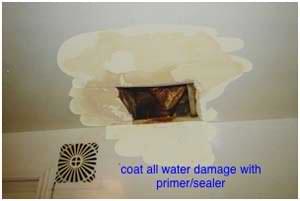
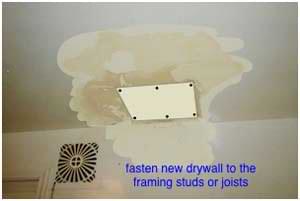
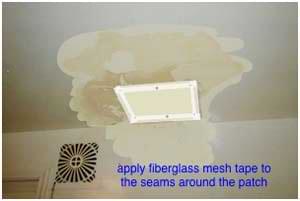
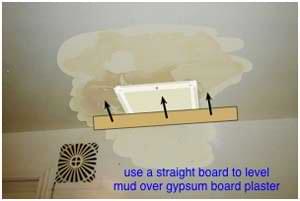
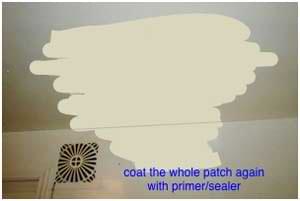
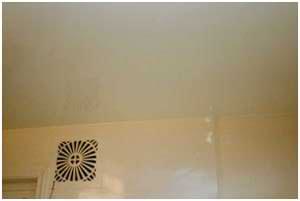
When exposed to a lot of water, drywall tends to warp equally the gypsum swells. When it dries, the gypsum may harden into a bulging wall or ceiling surface. This jutting gypsum will tend to exist harder than earlier it got moisture. This volition be true of plaster with gypsum board lath as well. Bulging gypsum like this will always need to be cut out and replaced to restore a flat surface.
Draw a square around the harm and cutting out the affected drywall. Trace the nearest existing drywall seams and forest framing to guide your cutting. Using the existing layout of the drywall volition give y'all framing to attach the replacement piece and brand information technology easier to cut the pigsty foursquare.
Use a drywall saw to cutting beyond the areas over hollow wall and a utility knife to score the drywall over wood framing.
Score repeatedly with a abrupt blade until you cut completely through the gypsum and backing paper. Remove any screws or nails holding the drywall up and pull the damaged area free.
Scrape off all damaged wall material surrounding the new pigsty and prime number the whole area with a primer/sealer.
Cutting a new piece of drywall of the same thickness and fit it into the infinite. Match the edges of the patching piece to the surrounding drywall edges. For example, if the drywall edges around the square hole are open with the gypsum core visible, cut the patch with open edges to match. This will foreclose an uneven articulation where the ii meet.
With gypsum board plaster, apply a slightly thinner piece of drywall to patch it. This will identify it a little below the surrounding surface allowing room to build up over the patch with joint compound and restore a matching smoothen surface.
Record the joints around the new piece of drywall with mesh tape and apply a start coat of mud using the techniques for finishing drywall seams. If the new patch is level with the surrounding surface, cease the seams as described. Permit the repair dry out completely and sand it smoothen. Wipe abroad the sanding dust and seal the whole repair with primer/sealer. When the sealer dries, bear on up the paint.
If the patching drywall is below the surrounding finished surface considering you lot're dealing with gypsum board plaster, apply the tape so it follows the contour of the seam and sticks flat to each surface. Then apply a thick coat of mud to the seams and skim off the backlog working beyond the record to smooth it out onto both surfaces. Employ light force per unit area to avert pulling the tape off but press hard enough to leave only a thin covering. Allow the mud ready and level out the uneven joint in the next step.
When the seams dries, apply a coat of mud to level out the patch. On big areas, use a slow acting setting compound like Durabond90® to give yourself time to work. Utilize a broad joint knife to employ a thick coat of mud that fills in over the drywall patch and overlaps the surrounding surface.
Immediately skim the excess mud from the patch to level it. Apply a straight border similar a 1x3 long plenty to span the whole repair and skim off the excess mud. Balance the board on the surrounding surface and draw it across the patch, stopping to remove the collected mud every bit you become.
Work beyond the patch to smooth out the surface. Around the perimeter, employ the joint knife to blend the mud with the surrounding surface. If necessary, go over the moisture mud a second time with the straight border to smooth out any missed spots. Ignore small voids or ridges in the mud coat, they will be filled in the next application.
Finishing Gypsum Board Plaster
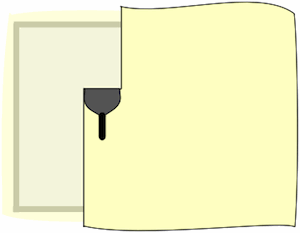
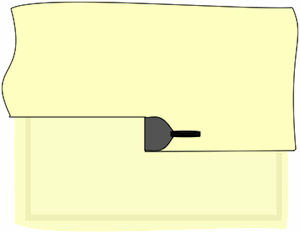
Let the mud set up for virtually an hour and scrape off any protrusions using the joint knife. Don't try to completely shine out the surface here, simply knock off any peaks or ridges in the mud. When the edges of the repair turn white, lightly sand there. Brush off the grit and wipe the surface with a damp rag to remove whatever articulation compound residuum.
Use a thick coat of mud over the whole patch again, overlapping the edges of the previous coat. Immediately skim the backlog mud off using the articulation knife. Brand parallel strokes across the patch using firm pressure with the knife. Ignore whatsoever ridges left by the edge of the blade, you will scrape them off when the mud sets.
Let the mud set and use the joint pocketknife to shave off whatsoever ridges in the surface. If necessary, lightly sand to smoothen around the edges and wipe off the grit. Use this procedure to apply as many subsequent mud coats as needed to build up a smooth surface over gypsum board plaster.
With each coat, skim in the opposite direction from the one before. If you skimmed vertically, apply the next with horizontal strokes. Reversing management like this with each application will aid eliminate whatsoever ripples or uneven surface.
Always overlap the edges of the previous coat of mud and skim it out as thin every bit possible around the perimeter to make terminal sanding easier. Allow the final coat of mud to set and dry completely before final sanding.
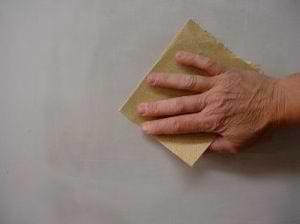
Sanding the Patch
Sand the dry out joint compound lightly with 120 sandpaper. Tear a 8x11 inch sheet in one-half to grade 2 8x5½ inch pieces. Fold one of the pieces in half and hold information technology with the fold away from y'all. Fan out your fingers to apply even force per unit area and apply a light bear upon. Start on ane side of a repair and sand in wide arching strokes to gradually smooth out imperfections.
Be careful sanding effectually the edges of patches on drywall. The sandpaper can dig in and tear the paper surface while you lot're trying to smooth out crude edges. Lightly sand across the edges to plumage a smooth transition between the 2 surfaces.
Brush all dust from the surface and wipe with a damp rag before priming and painting. If y'all are using flat latex finish paint, you tin can apply it to prime number the repair. If you are using semi-gloss or other shiny paint, prime with flat latex or a latex primer showtime.
- How to Repair Bubbling Pigment
- How to Repair Torn Drywall Paper
- Repairing Water Damaged Drywall
- Repairing H2o Damaged Plaster
- Repairing Crumbling Plaster
- Repairing Major Plaster Damage
- Repairing Wood Board Plaster
- Repairing Drywall Nail Pops
- Repairing Small Wall Holes
- Repairing Large Wall Holes
- Repairing Large Ceiling Holes
- Repairing Pocket-size Ceiling Holes
- Repairing Wall and Ceiling Cracks
- Repairing Cracks with Expanding Cream
- Installing a Drywall Ceiling
- Finishing Recessed Drywall Joints
- Finishing Metallic Drywall Corner Bead
- Finishing Paper Corner Bead
- Finishing Inside Drywall Corners
- Finishing Drywall Barrel Joints
- How to Practice Drywall Texturing
- Skim Blanket on Walls and Ceilings
- Sanding Drywall Joint Compound
- Wall Tools and Materials Guide
Source: https://www.do-it-yourself-help.com/repair-drywall-water-damage.html
Posted by: phillipsforef1961.blogspot.com


0 Response to "How To Repair Water Mark On Drywall"
Post a Comment